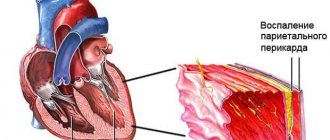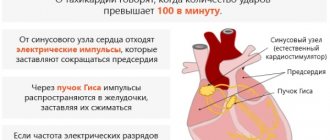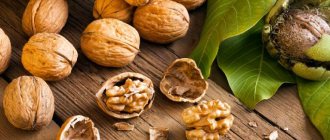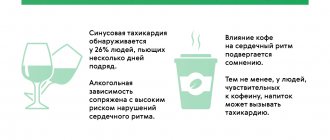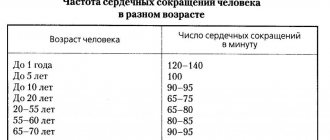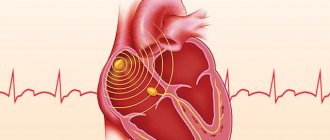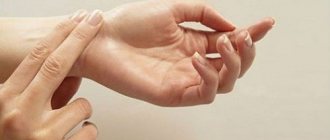In this article we will study an important characteristic of the heart - its pulse with a frequency of 80 beats per minute.
The pulse is a mirror reflection of the work of the heart itself. That is, this is the frequency of narrowing of the artery walls in response to heart contractions or beats. Each age and sex group has its own normal indicators. Therefore, a pulse of 80 beats cannot specifically indicate increased or increased indicators, because everyone has their own standards, which largely depend on lifestyle. The number of strokes of 80 is the maximum medical limit. But is it really dangerous and what to do in this case, we will find out in this article.
Heart rate indicators
The first thing every person should know is that a rapid pulse is how many beats there are in one minute, as well as what the normal limits are.
It is known that medicine calls an absolutely normal pulse of 60-80 beats in 60 seconds. And what’s interesting is that the younger a person is, the more often he experiences such a rhythm.
Depending on age, the pulse should show the following numbers:
For reference! In newborn infants, the normal heart rate is 140 beats per minute; in children aged 3 years and older, it is 100 beats per minute. Accordingly, in adulthood, for example, at 45 years old, the norm will be 70 strokes.
Pulse 80 beats per minute - is this normal: how to check what is normal?
It’s immediately worth noting why a pulse of 80 beats is cause for concern. Let us remind you that the heart rate (heart rate) should be similar to the number of pulse beats. And the higher the number of these contractions, the higher the load on the heart. But this does not necessarily require more blood to be pumped.
Important: The heart grows with a person, and also increases from regular physical activity. And a large heart makes significantly fewer contractions to pump the same amount of blood as a person without physical training and with an increased heart rate. For this reason, children's standards are slightly higher than those of adults! Also, do not forget that with age the frequency increases due to wear and tear of the heart. Therefore, the verdict is this: the lower the pulse, the better!
You can calculate the number of arterial beats or pulse rate (HR) at home yourself:
- on the wrist of the left or right hand, in the area of the radial artery. In this case, choose a place under the bend of the hand in the conditionally divided half on the left. That is, under the thumb
- can be measured along the ulnar artery also on the wrist, but on the right, conditionally under the little finger
- immediately at the beginning of the axilla on the axillary artery, in the area of the lateral wall
- a reliable and simple way to measure the pulse in the carotid artery, the so-called carotid pulse. A stronger blow is felt on the left side, but can also be measured on the right side of the neck. To do this, place the pads of your fingers just under the cheekbone.
Where and how to measure
It is worth noting that many people take such measurements at home using their thumb. But this is not entirely correct - the chance of incorrect calculation increases. Therefore, to determine the pulse, we use the pads of the thumb and middle fingers, and even better, together with the ring finger.
Important: Ideally, counting should be done for the entire minute, that is, 60 seconds. But methods are allowed when they count for 30 seconds and multiply by 2, or when they count only for 15 seconds and then multiply by 4.
What are the normal indicators?
Even when we rest, our heart continues to work. It's important to understand that there are many factors that affect your heart rate, such as age, weight, and even life situations. And what is good for one can be deadly for another.
Table of standards
As we can see from the table, the average value for an adult should not exceed the limit of 70-75. At the same time, the pulse rate can be used to judge the proper functioning of the cardiovascular system. And also a healthy person with a low heart rate lives significantly longer than those who have a high frequency. After all, the heart wears out to a lesser extent. Therefore, if your pulse is 80 beats per minute at rest, then this is already considered an overestimated reading! But we should not forget about other factors that influence such a norm. By the way, do not forget that the pulse should not be low either - the minimum acceptable limit is up to 50 beats!
Causes of tachycardia
Tachycardia is an increased heart rate that occurs regularly . Moreover, the situation when in a person it is higher than 100-120 beats per minute can be observed from 15 minutes to several days in a row.
And the first thing to begin with the examination and treatment of such patients is to determine the reasons and factors why the pulse and heartbeat increase.
There are different reasons:
Physiological - a more harmless situation, which can be corrected in alternative ways.
It could be:
- excessive smoking of tobacco products;
- taking drugs;
- excessive coffee consumption;
- physical and nervous overstrain;
- intellectual loads;
- insomnia;
- temperature increase;
- taking drugs of a certain group;
- hot weather.
Pathological is a dangerous situation that can only be corrected by a medical specialist and competent treatment. It could be:
- vascular and heart diseases;
- blood diseases;
- presence of oncological tumors;
- diseases of the nervous system;
- endocrine disorders;
- severe infectious diseases.
Important! Diuretics, hormones, hypotensive drugs, nitrates, caffeine-containing or vagolytic agents, as well as sympathomimetics can provoke the development of tachycardia.
Tachycardia - what are the symptoms?
A symptom of the development of tachycardia is an increased pulse, and as follows from the definition, an acceleration of the heart rate above 100-125 beats per minute. Patients describe their condition differently - “the heart is pounding like a hammer”, it wants to “jump out of the chest”, “the heart is beating unevenly”.
Strong and frequent heart beats may be accompanied by symptoms such as:
- dizziness,
- scotoma, darkness before the eyes,
- feeling of weakness,
- dyspnea,
- loss of consciousness.
If your heart is galloping like a driven horse while you are calm, you need to see a doctor and conduct additional diagnostic tests that will help you decide on further treatment. Tachycardia, due to many factors that can cause it, requires, first of all, treatment as an effect, which means eliminating the cause that causes it.
Consequences of increased heart rate
A pulse of 130 beats or more - is this normal or is it still dangerous?
The doctor will definitely notify him of the consequences of this condition.
Prolonged tachycardia can lead to the development of complex diseases, such as:
- arrhythmic shock;
- stroke;
- cerebral ischemia;
- thromboembolism;
- cardiac asthma;
- violation of metabolic processes;
- decreased immunity;
- acute ventricular failure.
An accelerated heart rate of 130 beats indicates certain risks, such as heart overload.
Which will sooner or later lead to its wear. The condition is accompanied by insufficient blood circulation and oxygen starvation, which will cause other organs and the brain to suffer.
Clinical picture of tachycordia
In order to promptly diagnose an attack of tachycardia, it is important to know the first and characteristic signs of this condition.
They are the following manifestations:
- darkness in the eyes;
- dizziness;
- dyspnea;
- prostration;
- lightheadedness or fainting.
Prevention of tachycordia
If tachycardia regularly makes itself felt, you should resort to a number of manipulations to stop the attack. In some cases, it will be necessary to provide primary medical care to the patient to stabilize the heart.
If an increase in heart rate occurs during physiological tachycardia, it is possible, by taking certain preventive measures, to stop the attack and thereby alleviate the patient’s condition.
Doctors recommend lying down for a while and trying to relax. The heart will calm down and the signs of tachycardia will disappear.
If this doesn't help, you should try this exercise:
- Inhale, tense your muscles, hold your breath, exhale and relax.
- Repeat several times until your heart calms down.
The purpose of the exercise is to activate the parasympathetic system. Its main carrier is the vagus nerve. By straining it, we stabilize the pulse.
Massaging the carotid artery helps a patient stop an incipient attack of tachycardia. It is necessary to apply light pressure with your fingertips on the neck area under the lower jaw. If you inadvertently put more pressure on the artery, you may faint.
Cold water will also help prevent an attack of tachycardia. You need to put it in a basin and immerse your face in water for one minute. Cold will help relax the heart and stabilize its functioning.
How to quickly reduce your heart rate to 80 beats at home?
If a pulse of 80 beats is not considered normal for you and arose spontaneously, then you should perform a number of certain actions:
- Stop temporarily physical or any other work
- Unbutton your collar or loosen your clothing at the neck area
- Take a comfortable position and try to relax
- Take a soothing drink or an hour with chamomile, lemon balm, mint and honey, as well as black currant
- If you feel that your general condition is worsening, then you should call a doctor. Emergency situations include symptoms such as chest pain, severe dizziness, numbness in the fingers and panic.
A pulse of 80 beats is not a critical limit for taking medications!
If necessary, your doctor may prescribe medications to lower your heart rate. Beta blockers and calcium antagonists are commonly used. They act differently in the blood vessels and heart, thereby helping to reduce heart rate and blood pressure.
As a rule, they are used primarily in patients with arterial hypertension and concomitant high pulse. In people with high blood pressure and a normal heart rate, these drugs may cause your heart rate to drop sharply. Drugs of both groups are rarely prescribed only to reduce heart rate.
Facilities
Treatment for high heart rate
A rapid pulse in men and women above 100 beats per minute can develop at any time of the day. This can happen day or night, during nervous shocks or at rest.
What this means can only be determined by the attending physician. First, you can provide first aid to the victim.
It is as follows:
- providing the patient with bed rest and rest;
- deep breaths for patients, holding their breath, generally measured deep breathing;
- performing simple breathing exercises, which consists of taking deep breaths and quick exhalations for 10 minutes.
For short-term attacks of tachycardia, homeopathic medications are first taken. For example, tincture of valerian or motherwort.
You can also take Valocordin or Corvalol on your own.
If the patient requires complex medical treatment, the following drugs are used:
- beta-blockers (for example, Metoprolol, Atenolol, Timolol, etc.);
- antiarrhythmic drugs (for example, Diltiazem);
- sodium or calcium channel blockers (for example, Verapamil or Novocainamide);
- thyreostatic agents (for example, Mercazolil);
- sedative sedatives (for example, Persen, Valerian, etc.);
- tranquilizers in advanced cases (for example, Phenazepam, Alprazolam, etc.).
Folk remedies
Traditional medicine will tell you what to take when your heart rate is elevated to normalize your readings.
The following plant substances are recognized as the best stabilizers of the heart, blood vessels, and blood pressure:
- Melissa;
- linden blossoms;
- chamomile flowers;
- stinging nettle;
- Birch buds;
- lavender blossoms;
- lemongrass;
- green parts of mistletoe;
- mistletoe.
Advice! Traditional medicine can be used in practice in parallel with basic drug treatment. The main thing is that the chosen means are approved by the attending cardiologist.
According to the standard recipe:
- take a couple of glasses of boiling water
- dissolve 2 tablespoons of any plant material in it
- after which the mixture boils in a water bath for about 10-15 minutes.
It is also important to ensure that the body receives the full amount of magnesium. It helps to reduce tissue permeability, as a result of which potassium cannot enter the blood in unlimited quantities.
It is recommended to eat more of:
- soy;
- nuts;
- legumes;
- bran;
- dark green vegetables;
- crayfish and shrimp;
- chocolate;
- cocoa.
Proper nutrition during tachycardia does not independently reduce the pulse, but creates conditions for the action of drugs and prevents an increase in rhythm.
Necessary:
- give up alcohol, coffee and caffeinated drinks, reduce cocoa and chocolate consumption;
- take food in fractional quantities, avoid overeating;
- drink enough water;
- exclude spicy and hot foods from the diet;
- Foods high in potassium and magnesium are beneficial: legumes, peaches, bananas, melon, nuts.
If the cause of a frequent rhythm is neurocirculatory dystonia, then non-drug methods are successfully used:
- baths: pine, with essential oils (geranium, sage, rose);
- relaxing massage;
- reflexology (acupuncture, acupressure);
- electrosleep.
Good effectiveness in slowing heart rate was noted for dosed physical activity. At a low level of training, walking, therapeutic and breathing exercises, and yoga are used.
Exercises should not cause discomfort.
High pulse - reasons
Although a rapid heartbeat in healthy people is a positive phenomenon that provides conditions for increased work of the body, this condition may not always be physiological. High pulse is sometimes caused by pathological reasons:
- the heart pumps too little blood, not enough to meet the needs of the body's cells,
- increased tissue demand for oxygen or nutrients (for example, at high temperatures),
- low quality of blood and low concentration of valuable products contained in it, such as oxygen and hemoglobin,
- poisoning with substances that reduce blood quality (carbon monoxide, ethylene glycol, methanol) or increase tissue demand (amphetamine, cocaine, some antidepressants, antipsychotics),
- as a result of bleeding and blood loss,
- an excess of endogenous catecholamines, that is, adrenal hormones responsible for stimulating the nervous system.
Of course, there can be many reasons for an increased heart rate, and this condition does not always have to be associated with pathology. In a healthy person, the pulse quickens in a calm state after drinking a cup of strong coffee or, with strong stimulation of the sympathetic nervous system, or, more simply, in a state of stress or with strong excitement.
In such cases, after the factor causing the increased heart rate ceases, the pulse becomes normal again.
In women during pregnancy, a high pulse is physiological in nature.
Is running safe with a heart rate of 120-130?
Running with a heart rate of 120-130 beats per minute is safe for the heart in the absence of diseases and for people under 55 years of age.
This load belongs to the recovery mode and helps:
- adapt the heart to the increased need for oxygen;
- open reserve capillaries;
- improve overall endurance;
- reduce the amount of fat in the body;
- strengthen muscles.
When training, trained athletes have a pulse of up to 150-160 beats. This rhythm leads to a gradual slowdown in resting heart rate if the training plan is correctly constructed.
If you are sick, you cannot rely on such numbers. It is necessary to choose a load that does not cause a deterioration in the nutrition of the heart; most often, a heart rate of 115-120 beats per minute is considered the limit.
How to cope with an attack of tachycardia?
If tachycardia (and the consequences of this disorder) is not the result of a disorder of the heart, but is only a physiological reaction to certain factors and situations, you can strive to limit the circumstances favorable to its occurrence:
- Limiting activity. According to cardiologists, rest is the best way to normalize your heart rate.
- Activation of the parasympathetic system. The frequency and strength of heart contractions are regulated by the sympathetic and parasympathetic systems. The main carrier of parasympathetic stimuli is the vagus nerve. The dominance of the sympathetic nervous system is associated with the fast work of the heart, since this system is responsible for preparing the body for the fight-flight response to stress. Therefore, in the event of tachycardia development, it is necessary to increase the impact on the parasympathetic system - stimulation of the vagus nerve initiates chemical processes, the result of which is to facilitate the work of the heart. To do this, take a deep breath and release the air, strongly tensing your muscles.
- Carotid artery massage requires prior medical advice on how to perform the procedure, as too vigorous movements can lead to inhibition of blood flow to the brain and fainting. You should gently massage the carotid artery - the place that needs to be pressed is on the border of the neck, deep under the lower jaw.
- Wetting your face with cold water. In marine mammals, swimming in cold water causes the heart to automatically release its function. Simply immerse your face in a container of cold water for 1-2 seconds. Sometimes this procedure interrupts the onset of tachycardia.
- Healthy regular meals, less sweets. Excessive consumption of sweets causes the pancreas to produce more insulin and causes periodic hypoglycemia. This condition causes the adrenal glands to produce additional adrenaline, which triggers the release of glycogen from the liver. Adrenaline (the main hormone of the sympathetic nervous system) stimulates the heart to work quickly, and the body is introduced into a state of uncontrollable excitement and fear.
Herbs and diet for tachycardia
Calming herbs, due to their properties, facilitate the stabilization of heart contractions. The following herbs are recommended:
- lemon balm,
- linden flower,
- nettle,
- chamomile,
- lavender,
- birch,
- ginkgo japonica,
- lemongrass,
- mistletoe,
- arjuna.
In addition to using soothing herbs, monitoring the level of magnesium in the body is necessary. It protects cells and balances the action of calcium in myocardial cells - the penetration of calcium into the cells stimulates contraction, and magnesium is the main component of enzymes that inhibits the influx of calcium into cells. The recommended daily dose of magnesium for women is 280 mg, for men - 350 mg.
Sources of magnesium:
- soybean,
- nuts,
- green beans,
- bran and grains,
- vegetables with dark green leaves, such as spinach,
- crustaceans,
- chocolate and cocoa.
A good solution is to use magnesium supplements.
People with heart problems need to monitor potassium levels. This is another element that affects the excitability of the muscle fibers of the heart. Its deficiency can be caused by excess sodium in the body, mainly salt from food, or the use of diuretics and laxatives.
Drug and surgical treatment
There are many drugs that are effective in treating coronary heart disease or hypertension. For complex types of tachycardia, beta-blockers or antiarrhythmic drugs are most often used. But they are not always effective or their use is associated with serious side effects. If drug treatment is unable to help, surgical treatment methods are used: implantation of a defibrillator. This procedure is performed in situations where the patient has experienced severe attacks of tachyarrhythmia and if there is a possibility of their reoccurrence.
The main function of this device is to stop ventricular tachycardia, flutter or ventricular fibrillation using electrical impulses. The defibrillator constantly analyzes the heart rhythm. It intervenes when it is too fast or too slow (so it also functions as a pacemaker). If it detects an accelerated heartbeat, then it sends weak electrical impulses that prevent tachyarrhythmia. When this is found to be ineffective, it sends a single strong electrical pulse synchronized with the heart's rhythm. It is unpleasant for the patient. It may be perceived as a blow, and even chest pain, but, as a rule, this interrupts a dangerous arrhythmia, including ventricular fibrillation, and restores the correct rhythm.
A chronically persistent high pulse of 120-130 beats per minute may warrant a visit to the doctor. A healthy person wishing to restore their elevated heart rate to normal should try to avoid substances that stimulate the heart, such as coffee (or caffeine from other sources), energy drinks, etc. For nervous patients, it may be helpful to restore a normal resting heart rate. studying relaxation techniques, aromatherapy, music therapy.
(
2 ratings, average: 5.00 out of 5)
Recommendations from experts
To prevent the development of pathological tachycardia, it is recommended to lead a healthy lifestyle:
- spend more time in the fresh air,
- quit smoking,
- drink less alcohol.
It is necessary to sleep enough hours, try not to overload yourself physically, and avoid stress.
You can find out how to lower your heart rate when your heart rate is 130 beats per minute or higher by consulting a doctor.
- In severe cases, you need to call an ambulance and provide first aid to the patient. And then undergo a course of treatment with medications of different groups.
- The folk remedies indicated in the article are suitable for the prevention of tachycardia and further stabilization of the condition after the main treatment.

